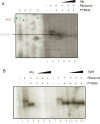Translational regulation by bacterial small RNAs via an unusual Hfq-dependent mechanism
- PMID: 29294046
- PMCID: PMC5861419
- DOI: 10.1093/nar/gkx1286
Translational regulation by bacterial small RNAs via an unusual Hfq-dependent mechanism
Abstract
In bacteria, the canonical mechanism of translational repression by small RNAs (sRNAs) involves sRNA-mRNA base pairing that occludes the ribosome binding site (RBS), directly preventing translation. In this mechanism, the sRNA is the direct regulator, while the RNA chaperone Hfq plays a supporting role by stabilizing the sRNA. There are a few examples where the sRNA does not directly interfere with ribosome binding, yet translation of the target mRNA is still inhibited. Mechanistically, this non-canonical regulation by sRNAs is poorly understood. Our previous work demonstrated repression of the mannose transporter manX mRNA by the sRNA SgrS, but the regulatory mechanism was unknown. Here, we report that manX translation is controlled by a molecular role-reversal mechanism where Hfq, not the sRNA, is the direct repressor. Hfq binding adjacent to the manX RBS is required for sRNA-mediated translational repression. Translation of manX is also regulated by another sRNA, DicF, via the same non-canonical Hfq-dependent mechanism. Our results suggest that the sRNAs recruit Hfq to its binding site or stabilize the mRNA-Hfq complex. This work adds to the growing number of examples of diverse mechanisms of translational regulation by sRNAs in bacteria.
Figures








References
Publication types
MeSH terms
Substances
Grants and funding
LinkOut - more resources
Full Text Sources
Other Literature Sources
Molecular Biology Databases

